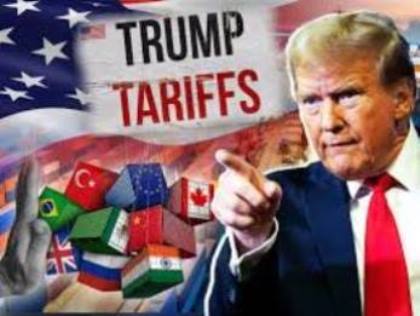In early April, US President Donald Trump introduced a wave of tariffs that sent financial markets in a freefall. However, on the 9th of April, Trump announced a 90-day pause on the tariffs for many nations. Due to this, extreme volatility has hit global stock markets, leaving many investors concerned and confused about their investments.
Search volumes for “protect my investment” soared by almost 80%, and searches for “protect investment portfolio” rose by 69%. Amid this uncertainty, forex experts BrokerChooser has revealed their tips on how investors can navigate the turbulence and how to safeguard portfolios during unpredictable times.
How do the tariffs impact the market?
“Periods of extreme volatility are what separate professionals from beginners. This is a time for skill, prudence, and discipline, not panic.” — Krisztián Gátonyi from forex experts BrokerChooser
Many US-based companies rely on imported components such as tech or auto parts, and with tariffs inflating the price of these imports, it has a natural impact on the consumer, as US companies are forced to raise prices to retain a profit.
Fears that the tit-for-tat tariffs will exacerbate inflation and push the global economy into recession have directly impacted the financial markets, as sell-offs have initiated around the world where investors are quick to sell shares in companies they think will be damaged by the tariffs, which in turn causes prices to drop and move to safe-haven assets.
Since Trump’s announcement of the 90-day pause, the FTSE100 saw a sharp surge, climbing as much as 6.2pc immediately, and the benchmark S&P 500 had its third-best day since 1939, closing 9.5pc higher.2 However, despite the 90-day pause, investments may still be vulnerable as the longer-term picture remains unclear.
How do investments get impacted?
All of this movement heavily impacts investors, with increased market volatility, reduced confidence in the economy, and fears of recession—as well as difficulty forecasting due to quickly changing policies.
Investors may move to safe-havens, (such as 10-year U.S. Treasury bonds), reposition to defensive plays, and move to Index ETFs or more liquid equities and large-cap stocks such as Apple, Microsoft, and Amazon due to the ease of entry and exit, less price slippage, and more stable pricing.
In a market shaken by Trump’s tariffs and constant volatility, the urge to sell assets is natural – but doing so risks missing the sharp rebounds that often follow. By exiting in fear, investors may rob themselves of the very gains they’re hoping to protect.
How to safeguard portfolios during unpredictable times
Stick to risk management discipline:
Volatility is a double-edged sword. While big swings can mean big opportunities, they can also wipe out positions in minutes, if not properly managed. This means different things for an investor and for a trader.
-
Volatility creates opportunity and risk – For investors, volatility offers the opportunity to invest at a discount, while for a trader, increased volatility can trigger their stop-loss. However, with proper position sizing and stop-loss, traders can make extra profit as well. Control position sizes and leverage (both should be lower than during less volatile times) to avoid forced liquidation during sudden moves.
-
Use stop-loss and limit orders – For a trader, it’s wise to cap losses and shield orders from extreme price swings by using stop-loss and limit orders. These aren’t just nice-to-have features during heightened volatility — they’re an essential safety net. For long-term investors, stop-loss orders aren’t necessary because short-term volatility can trigger a sale, locking in losses, even if the asset’s long-term outlook remains strong.
-
Limit emotionally led decisions – Panic moves are easy during times of uncertainty; avoid panic selling or overtrading based on fear, greed, or excitement. Headlines and social media can easily influence traders with rumours and fear-mongering, clouding judgement, and leading to panic selling.
-
Set clear risk limits before you enter a position – then stick to the plan. Additionally, wait for confirmation of policy moves before committing heavily, and use smaller “feeler” positions to test market reaction.
Fight the gap:
According to the forex experts BrokerChooser, sudden jumps or dips in asset prices between trading sessions (sometimes as much as 20pc-30pc) are particularly common during periods of high uncertainty. These are referred to as gaps and are particularly crucial for traders.
-
Use guaranteed stop-loss orders (GSLOs) – GSLOs ensure your trade closes at your chosen level, even if the market gaps. They usually carry a small fee, but they are the only way to fully protect against slippage in a gap.
-
Avoid holding positions over the weekend – Unless your strategy explicitly requires it (e.g. long-term swing trades), close intraday or tactical positions before the weekend, when major gap risk looms largest. This applies to traders, not investors.
-
Reduce leverage around key events – If you’re trading near expected announcements (e.g. Trump speeches, G7 meetings, tariff deadlines), scale back your position size or use less leverage. This gives you a buffer in case the market gaps against you.
Krisztián Gátonyi, Expert at BrokerChooser, adds: If you’re trading with leverage, be cautious – brokers can raise margin requirements due to increasing volatility. In such situations, you may face a margin call or even end up with a negative balance.
Exploit overreactions (carefully):
In volatile markets, stock prices can often overshoot their fundamentals due to market rumors or news events, creating opportunities for investors who are quick to identify these discrepancies. Skilled investors can capitalize on such mispricings by buying into the stock when its price deviates too far from its intrinsic value – but only with proper risk management in place.
For example, if a well-known stock like Apple (AAPL) drops significantly after an earnings miss or a brief negative headline, but there is no significant change to the company’s long-term outlook, an experienced investor might see this as an opportunity to purchase shares at a discount. They anticipate that once the market corrects itself and rationality returns, the stock price will likely rebound toward its true value.
These types of opportunities, where the price deviates from the underlying fundamentals, can be rewarding if you correctly identify when the price movement is driven by panic or misinformation, rather than a genuine change in fundamentals.
Krisztián Gátonyi, Expert at BrokerChooser, adds: “Volatility creates mispricings. The investor who can keep their head cool can step in when others rush for the exits.”
Maintain a long-term perspective:
Keep an eye on the horizon—despite the current turbulence, consider what the landscape might look like 6 or 12 months out.
Look for value amid the wreckage – A fundamentally solid currency that’s oversold due to temporary trade fears could be a great longer-term play. For example, if the euro plunges on a tariff escalation but you believe Europe’s economy will weather the storm better than the U.S. expects, you might position for a medium-term rebound.
Emerging markets with sound fundamentals but beaten-down currencies could offer mean-reversion trades once the dust settles. Gátonyi notes that prudent portfolio management requires focusing on long-term goals, rather than getting distracted by daily market fluctuations.
Gátonyi adds: “Volatility can be harnessed for short-term gains, but don’t lose sight of core convictions,” he says. “If the long-term trend for a currency or economy remains intact, volatility might just give you a better entry point.” Balance your short-term tactics with an overarching strategy for when stability returns.


















